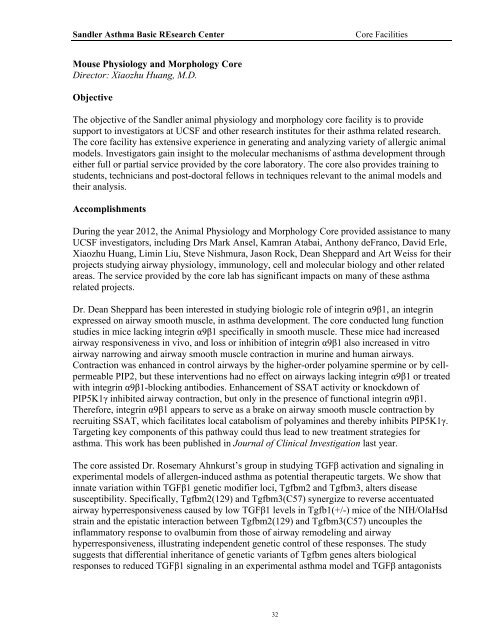download - Sandler Asthma Basic Research Center - University of ...
download - Sandler Asthma Basic Research Center - University of ...
download - Sandler Asthma Basic Research Center - University of ...
You also want an ePaper? Increase the reach of your titles
YUMPU automatically turns print PDFs into web optimized ePapers that Google loves.
<strong>Sandler</strong> <strong>Asthma</strong> <strong>Basic</strong> REsearch <strong>Center</strong>Core FacilitiesMouse Physiology and Morphology CoreDirector: Xiaozhu Huang, M.D.ObjectiveThe objective <strong>of</strong> the <strong>Sandler</strong> animal physiology and morphology core facility is to providesupport to investigators at UCSF and other research institutes for their asthma related research.The core facility has extensive experience in generating and analyzing variety <strong>of</strong> allergic animalmodels. Investigators gain insight to the molecular mechanisms <strong>of</strong> asthma development througheither full or partial service provided by the core laboratory. The core also provides training tostudents, technicians and post-doctoral fellows in techniques relevant to the animal models andtheir analysis.AccomplishmentsDuring the year 2012, the Animal Physiology and Morphology Core provided assistance to manyUCSF investigators, including Drs Mark Ansel, Kamran Atabai, Anthony deFranco, David Erle,Xiaozhu Huang, Limin Liu, Steve Nishmura, Jason Rock, Dean Sheppard and Art Weiss for theirprojects studying airway physiology, immunology, cell and molecular biology and other relatedareas. The service provided by the core lab has significant impacts on many <strong>of</strong> these asthmarelated projects.Dr. Dean Sheppard has been interested in studying biologic role <strong>of</strong> integrin α9β1, an integrinexpressed on airway smooth muscle, in asthma development. The core conducted lung functionstudies in mice lacking integrin α9β1 specifically in smooth muscle. These mice had increasedairway responsiveness in vivo, and loss or inhibition <strong>of</strong> integrin α9β1 also increased in vitroairway narrowing and airway smooth muscle contraction in murine and human airways.Contraction was enhanced in control airways by the higher-order polyamine spermine or by cellpermeablePIP2, but these interventions had no effect on airways lacking integrin α9β1 or treatedwith integrin α9β1-blocking antibodies. Enhancement <strong>of</strong> SSAT activity or knockdown <strong>of</strong>PIP5K1γ inhibited airway contraction, but only in the presence <strong>of</strong> functional integrin α9β1.Therefore, integrin α9β1 appears to serve as a brake on airway smooth muscle contraction byrecruiting SSAT, which facilitates local catabolism <strong>of</strong> polyamines and thereby inhibits PIP5K1γ.Targeting key components <strong>of</strong> this pathway could thus lead to new treatment strategies forasthma. This work has been published in Journal <strong>of</strong> Clinical Investigation last year.The core assisted Dr. Rosemary Ahnkurst’s group in studying TGFβ activation and signaling inexperimental models <strong>of</strong> allergen-induced asthma as potential therapeutic targets. We show thatinnate variation within TGFβ1 genetic modifier loci, Tgfbm2 and Tgfbm3, alters diseasesusceptibility. Specifically, Tgfbm2(129) and Tgfbm3(C57) synergize to reverse accentuatedairway hyperresponsiveness caused by low TGFβ1 levels in Tgfb1(+/-) mice <strong>of</strong> the NIH/OlaHsdstrain and the epistatic interaction between Tgfbm2(129) and Tgfbm3(C57) uncouples theinflammatory response to ovalbumin from those <strong>of</strong> airway remodeling and airwayhyperresponsiveness, illustrating independent genetic control <strong>of</strong> these responses. The studysuggests that differential inheritance <strong>of</strong> genetic variants <strong>of</strong> Tgfbm genes alters biologicalresponses to reduced TGFβ1 signaling in an experimental asthma model and TGFβ antagonists32


